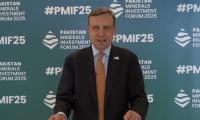LONDON: OPEC has raised its 2023 global oil demand growth forecast in its first upward revision for months, due to China's relaxation of Covid-19 restrictions, and trimmed supply forecasts for Russia and other non-OPEC producers, pointing to a tighter market.
Global oil demand will rise this year by 2.32 million barrels per day (bpd), or 2.3 percent, the Organization of the Petroleum Exporting Countries said on Tuesday in a monthly report.
The projection is 100,000 bpd higher than last month's forecast.
A tighter supply and demand balance could support oil prices that have held relatively steady since December and stand at a little less than $86 a barrel. OPEC had kept its 2023 demand growth forecast steady for the past two months after a series of downgrades as the economic outlook worsened.
"Key to oil demand growth in 2023 will be the return of China from its mandated mobility restrictions and the effect this will have on the country, the region and the world," OPEC said in the report.
"Concern hovers around the depth and pace of the country's economic recovery and the consequent impact on oil demand."
OPEC expects Chinese demand to grow by 590,000 bpd in 2023, up from last month's forecast of 510,000 bpd. China's oil consumption dropped for the first time in years in 2022, held back by its Covid containment measures.
The OPEC report was upbeat on economic prospects, nudging up its 2023 global growth forecast to 2.6 percent from 2.5 percent, though it said that a relative slowdown remained evident and cited high inflation and expected further increases to interest rates.
Other upside factors are the likelihood that the U.S. Federal Reserve will manage a soft landing for the U.S. economy and further commodity price weakness, OPEC said, although various potentially negative factors persist.
"Downside risks are apparent and may include further geopolitical tensions in eastern Europe, China's ongoing domestic challenges amid the pandemic, and potential spillovers from China's still fragile real estate sector," OPEC said.
Oil was down more than $1, moving towards $85, after the report was released.
The report also showed that OPEC's crude oil production fell in January after the wider OPEC+ alliance pledged output cuts to support the market.
For November last year, with prices weakening, OPEC+ agreed to a 2 million bpd reduction in its output target - the largest since the early days of the pandemic in 2020. OPEC's share of the cut is 1.27 million bpd.
In the report, OPEC said its crude oil output in January fell by 49,000 bpd to 28.88 million bpd as declines in Saudi Arabia, Iraq and Iran offset increases elsewhere.
OPEC also lowered its forecast of 2023 growth in supply from producers outside the group to 1.4 million bpd, from 1.5 million bpd last month, citing lower expectations from Russia and the United States.
Russia said last week it will cut oil production by 500,000 bpd in March after the West imposed price caps on Russian oil and oil products over its invasion of Ukraine.
This representational image shows a shadow of two graduate students. — AFP/File LAHORE: Zahida Habib has...
A picture of MoU signing between National Foods and Abhi, April 8, 2025. —Facebook@nationalfoodsnewsKARACHI: ABHI...
This undated file image shows a set of gold bangles. — AFPKARACHI: Gold prices fell by Rs2,000 per tola on Tuesday...
This representational image shows a calculator on the table along with a file that shows "budget" written on it.. —...
Meta founder Mark Zuckerberg, Amazon founder Jeff Bezos, and Tesla CEO Elon Musk. — Reuters/FileThe world’s 500...
The KTBA building seen in this undated image.— KTBA website/FileKARACHI: The Karachi Tax Bar Association on Tuesday...







